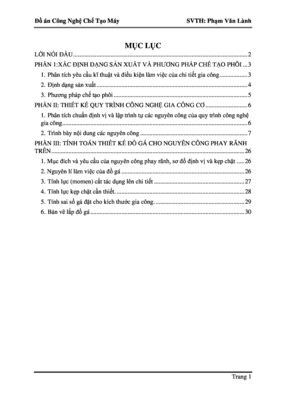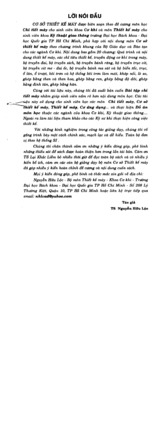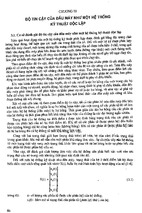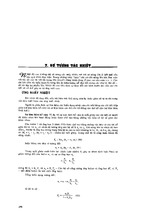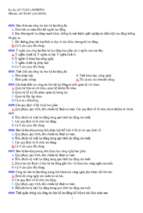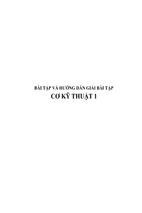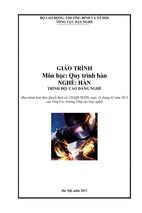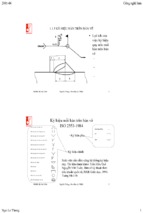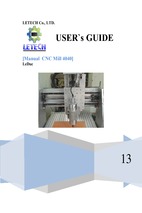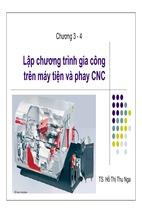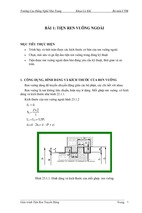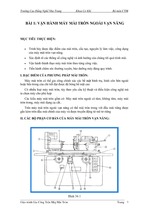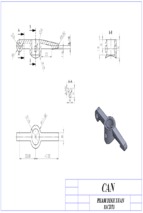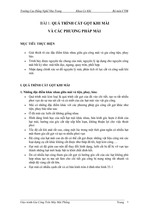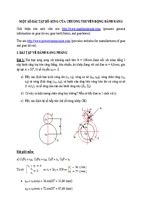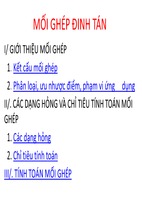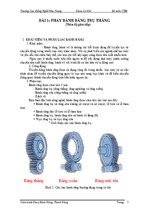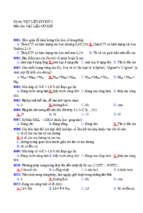MH 22-AV CHUYÊN NGÀNH HÀN
BỘ LAO ĐỘNG -THƢƠNG BINH VÀ XÃ HỘI
TỔNG CỤC DẠY NGHỀ
GIÁO TRÌNH
Tiếng Anh chuyên ngành
NGHỀ: HÀN
TRÌNH ĐỘ: CAO ĐẲNG NGHỀ
(Ban hành kèm theo Quyết định số:120/QĐ-TCDN ngày 25 tháng 02 năm 2013
của Tổng Cục trưởng Tổng cục Dạy nghề)
Hà Nội, năm 2013
1
TUYÊN BỐ BẢN QUYỀN
Tài liệu này thuộc loại sách giáo trình nên các nguồn thông tin có thể được
phép dùng nguyên bản hoặc trích dùng cho các mục đích về đào tạo và tham
khảo.
Mọi mục đích khác mang tính lệch lạc hoặc sử dụng với mục đích kinh
doanh thiếu lành mạnh sẽ bị nghiêm cấm.
LỜI GIỚI THIỆU
Để đáp ứng nhu cầu về tài liệu học tập ngoại ngữ chuyên ngành cho học
sinh - sinh viên và giáo trình giảng dạy cho giáo viên các trường dạy nghề, Tổ
môn Ngoại ngữ Trường Cao đẳng nghề GTVT Trung ương 2 đã biên soạn cuốn
giáo trình “Anh văn chuyên ngành công nghệ Hàn”. Cuốn giáo trình được
biên soạn với mục tiêu giúp người học đọc hiểu các ký hiệu, ký tự trên bản vẽ
bằng Tiếng Anh; đọc hiểu các tài liệu Tiếng Anh về nguyên lý và cách vận hành
các loại máy hàn; đọc hiểu các nội dung tài liệu viết bằng Tiếng Anh về các loại
vật liệu hàn; đọc hiểu các loại quy trình hàn và các phương pháp gia nhiệt theo
tiêu chuẩn quốc tế; dịch tài liệu ngành hàn từ Tiếng Anh sang Tiếng Việt; viết
các quy trình hàn bằng Tiếng Anh.
Trong quá trình biên soạn, chúng tôi đã tham khảo nhiều tài liệu của các
trường đại học, cao đẳng, chương trình khung của Tổng cục dạy nghề ban hành,
các trường dạy nghề quốc tế như City & Guilds, Sunderland – Anh Quốc, cũng
như các tài liệu , tiêu chuẩn nước ngoài như ASME , ANSI, AWS, AIP....để đáp
ứng các yêu cầu thực tế đặt ra trong quá trình sản xuất . Trang bị cho giáo viên
các kiến thức chuyên môn trong hội nhập quốc tế đáp ứng yêu cầu của doanh
nghiê ̣p.
Mặc dù đã có nhiều cố gắng song không thể tránh khỏi những thiếu sót.
Rất mong được đồng nghiệp và các bạn đọc đóng góp ý kiến để giáo trình ngày
càng hoàn chỉnh hơn./.
Chúng tôi xin chân thành cảm ơn!
Hà Nội, ngày
tháng
năm 2013
Chủ biên: Trịnh Thị Kim Huế
2
MỤC LỤC
TRANG
I.
Lời giới thiệu
1
II.
Mục lục
2
III.
Vị trí, tính chất môn học
3
IV.
Mục tiêu của môn học.
3
V.
Nội dung môn học
VI.
Unit 1: Terminology and standard
5
Unit 2: Welded joint and weld
11
Unit 3: Imperfection welding
17
Unit 4: Welding technology
30
Unit 5: Welding procedure
45
Unit 6: Equipment and tools for welding
74
Trả lời các câu hỏi và bài tập
95
VII. Thuật ngữ và định nghĩa trong hàn kim loại
107
VIII. Tài liệu tham khảo
113
3
TÊN MÔN HỌC: ANH VĂN CHUYÊN NGÀNH HÀN
Mã môn học: MH 22
Vị trí, tính chất, ý nghĩa và vai trò của môn học:
- Vị trí: Là môn học được bố trí cho người học sau khi đã học xong các
môn học chung theo quy định của Bộ LĐTB-XH.
- Tính chất: Là môn học chuyên môn nghề.
- Ý nghĩa và vai trò: Môn học Anh văn chuyên ngành hàn có ý nghĩa và
vai trò vô cùng quan trọng và cần thiết đối với các học sinh, sinh viên học nghề
trong thời kỳ hội nhập bởi nó cung cấp một số lượng lớn các từ vựng chuyên
ngành hàn, các nội dung về nghề hàn và mẫu câu cần thiết để học sinh, sinh viên
có thể đọc hiểu và dịch được các tài liệu chuyên môn bằng Tiếng Anh.
Mục tiêu của môn học
- Đọc hiểu các ký hiệu, ký tự trên bản vẽ bằng Tiếng Anh.
- Đọc hiểu các tài liệu Tiếng Anh về nguyên lý và cách vận hành các loại
máy hàn.
- Đọc hiểu các nội dung tài liệu viết bẳng Tiếng Anh về các loại vật liệu
hàn.
- Đọc hiểu các loại quy trình hàn và các phương pháp gia nhiệt theo tiêu
chuẩn quốc tế.
- Dịch tài liệu ngành hàn từ Tiếng Anh sang Tiếng Việt.
- Viết các quy trình hàn bằng Tiếng Anh.
Nội dung của môn học:
Thời gian
Số
TT
I
II
III
IV
Tên chƣơng mục
Terminology and standard
1. Vocabulary
2. Grammar
3. Main text
Welded joint and weld
1. Vocabulary
2. Grammar
3. Main text
Imperfection welding
1. Vocabulary
2. Grammar
3. Main text
Welding technology
1. Vocabulary
2. Grammar
Tổng
số
Lý
thuyết
4
1
1
2
8
1
2
5
16
3
4
9
24
2
4
4
1
1
2
4
1
2
1
8
2
1
5
10
2
1
Bài tập Kiểm tra*
thực
(LT hoặc
hành
TH)
0
0
0
0
4
0
0
4
8
1
3
4
13
0
3
0
0
0
0
0
0
0
0
0
0
0
0
1
0
0
4
Thời gian
Số
TT
V
VI
VII
Tên chƣơng mục
3. Main text
Welding procedure
1. Vocabulary
2. Grammar
3. Main text
Equipment and tools for
welding
1. Vocabulary
2. Grammar
3. Main text
Kiểm tra kết thúc
Cộng
Bài tập Kiểm tra*
thực
(LT hoặc
hành
TH)
Tổng
số
Lý
thuyết
18
24
2
4
18
7
10
2
1
7
10
13
0
3
10
1
1
0
0
1
12
4
8
0
1
3
8
2
90
1
1
2
0
40
0
2
6
0
46
0
0
0
2
4
5
UNIT 1: TERMINOLOGY AND STANDARD
Mã bài: MH 22.1
Giới thiệu:
Để đọc và dịch Tiếng Anh chuyên ngành hàn hiệu quả thì việc hiểu và vận
dụng các thuật ngữ trong ngành hàn, các ký hiệu viết tắt về phương pháp hàn,
các tiêu chuẩn, quy phạm kỹ thuật là vô cùng quan trọng và cần thiết.
Mục tiêu:
- Đọc hiểu các thuật ngữ trong ngành hàn bằng Tiếng Anh;
- Đọc hiểu các ký hiệu viết tắt Tiếng Anh về các phương pháp hàn;
- Đọc hiểu các tiêu chuẩn, quy phạm kỹ thuật Tiếng Anh trong cơ khí nói
chung và ngành hàn nói riêng;
- Dịch các tài liệu tiếng việt về thuật ngữ hàn sang Tiếng Anh.
1. Vocabulary
Mục tiêu:
- Liệt kê được một số thuật ngữ trong ngành hàn: các phương pháp hàn,
các liên kết hàn, các thiết bị hàn.
- Phát âm chuẩn và nắm vững nghĩa của các thuật ngữ đó.
- Tuân thủ các quy tắc phát âm theo ký hiệu phiên âm quốc tế.
1.1. Reading
- Arc:
Hồ quang
- Edge :
Cạnh hàn
- Metal:
Kim loại hàn
- Joint:
Liên kết hàn
- Electrode :
Điện cực
- Welding :
Hàn
- Welded joint:
Liên kết hàn
- Welding process: Quy trình hàn
- Weld:
Mối hàn
- Welding structure: Kết cấu hàn
- Melt:
Sự nóng chảy
- Molten:
Nấu chảy
- Mass:
Khối lượng
- Cool:
Làm nguội
- Clamp:
Kẹp lại, giữ lại
- Base metal:
Kim loại cơ bản
- Circuit:
Mạch điện
- Stream:
Dòng, luồng
- Temperature:
Nhiệt độ
- Bright:
Sáng, sáng chói
- Welding machine: Máy hàn
- Amperage:
Cường độ dòng điện
- Voltage:
Điện áp
- Generator:
Máy phát điện
- Transformer:
Máy biến thế
6
- Rectifier:
Bộ chỉnh lưu
1. 2. Explanation
- Base metal: Kim loại cơ bản - Kim loại hoặc hợp kim được hàn hoặc cắt.
In chemistry, the term base metal is used informally to refer to a metal
that oxidizes or corrodes relatively easily, and reacts variably with diluted
hydrochloric acid (HCl) to form hydrogen. Examples include iron, nickel, lead
and zinc. Copper is considered a base metal as it oxidizes relatively easily,
although it does not react with HCl.
- Welding process: Quá trình Hàn - Tập hợp các nguyên công cơ bản được
sử dụng trong hàn, cắt bằng nhiệt hoặc phun phủ bằng nhiệt.
The AWS definition for a welding process is "a materials joining process
which produces coalescence of materials by heating them to suitable
temperatures with or without the application of pressure or by the application of
pressure alone and with or without the use of filler material".
- Welded joint: Liên kết hàn là liên kết được thực hiện bằng phương pháp
hàn.
The joining of two or more metallic components by introducing fused
metal (welding rod) into a fillet between the components or by raising the
temperature of their surfaces or edges to the fusion temperature and applying
pressure (flash welding).
1.3. Examples
- There are many different kinds of welding machines nowsaday.
- Several approaches have been developed to analyze welding structures.
2. Grammar: Passive voice
Mục tiêu:
- Trình bày được cách sử dụng, cấu trúc của câu bị động.
- Kết hợp sử dụng các thuật ngữ chuyên ngành để đặt câu theo cấu trúc bị
động (chuyển câu chủ động sang câu bị động và ngược lại).
- Tuân thủ nghiêm túc các bước chuyển từ câu chủ động sang câu bị động
và ngược lại.
2.1. Form and use
Subject (S) + Verb (V) + Object ( O)
S
+
Be
+
V_ed ( past participle) + (by….)
- The passive of an active tense is formed by putting the verb to be into
the same tense as the active verb and adding the past participle of the active
verb. The subject of the active verb becomes the ‗agent’ of the passive verb.
7
The ‗agent’ is very often not mentioned. When it is mentioned it is preceded by
by and placed at the end of the clause:
E.g:This metal of plate was welded by my father.
- Passive voice is used when the focus is on the action. It is not important
or not known, however, who or what is performing the action.
2.2. Present and past tenses
S
+
V
+
O
S
+
is / are + V- ed
Active: We build this bridge.
Passive: This bridge is built.
S
S
+ V ( past simple) + O
+ was / were + V_ ed
Active: They broke the window.
Passive: The window was broken.
2.3. The passive of continuous tenses
S + is / am / are + V_ing
+ O
S + is / are + being + V_ed ( past participle)
Active: they are repairing the bridge.
Passive: The bridge is being repaired.
2.4. Modal verbs: Can & should
S + should / can
+V
+ O
S + should / can
+ be +
V_ed ( past participle)
Active: You should shut these doors
Passive: These doors should be shut
Active: You can use the process to deposit metal to form a surface with
alternative properties.
Passive: The process can also be used to deposit metal to form a surface
with alternative properties.
8
3. Main text
Mục tiêu:
-Trình bày được định nghĩa, đặc điểm của hàn hồ quang tay; các loại máy
hàn và những yêu cầu về nguồn điện để đảm bảo chất lượng mối hàn; một số kí
hiệu về tiêu chuẩn mối hàn.
- Đọc và trả lời được các câu hỏi liên quan đến nội dung bài đọc.
- Thực hiện nghiêm túc và hiệu quả kĩ năng đọc hiểu.
3.1. Arc welding
3.1.1. Reading
This lesson is a method of joining two pieces of metal into one solid
piece. To do this, the heat of an electric arc is concentrated on the edges of two
pieces of metal to be joined. The metal melts and, while these edges are still
molten, addition melted metal is added. This molten mass cools and solidifies
into one solid piece.
Figure 1.1
The electric arc is made between the work and the tip and of a small metal
wire, the electrode, which is clamped in a holder and held in the hand. A gap is
made in the welding circuit by holding the tip of the electrode 1/16‘‘-1/8‘‘ away
from or base metal being welded. The electric current jumps this gap and make
an arc, which is held and moved along the joint to be welded, melting the metal
as it is moved.
Arc welding is a manual skill requiring a steady hand, good general
physical conditions, and good eyesight. The operator controls the welding arc
and, therefore, the quality of the weld made.
Figure1.2
9
Figure 1.3 Illustrates the action that takes place in the electric arc. It
closely resembles what is actualy seen during welding
The ― arc stream ‖ is seen in the middle of the picture. This is the electric
arc created by the electric current flowing through the space between the end of
the electrode and the work. The temperature of this arc is about 6000 0C, which
is more than enough to melt metal. The arc is very bright, as well as hot, and
cannot be looked at with the naked eye without risking painful, though usualy
temporary injury.
Figure 1.3
The arc melts the plate, or base, metal and actually digs into it, much as
the water through a nozzle on a garden hose digs into the earth. The molten
metal forms a molten pool or crater and tends to flow away from the arc. As it
moves away from the arc, it cools and solidifies. A slag forms on top of the weld
to protect it during cooling.
The several types of welding machines include motor-generators, enginedriven generators, transformers, rectifiers, and combination transformer and
rectifiers. Each type has its place and purpose. The basic function of each is the
same-providing a source of controlled electric power for welding. This
controlled electric power has the characteristic of high amperage at low voltage.
The high amperage is repuired to provide sufficient heat at the arc. The voltage
must be low enough to be safe for handling and yet high enough to maintain the
arc. The welder (machine) permits the welder (operator) to control the amount
of current he uses. This, in turn, controls the amount of heat of the arc. Some
welders also permits the operator to select either a forceful or soft arc and to
control its charcteristics to suit the job.
3.1.2. Words and phrases
- Solid piece
- Melted metal
- A gap is made in the welding circuit
- Make an arc
- The quality of the weld made
- Welding arc
10
- Arc stream
- Crater
- Flow away from the arc
3.1.3. Questions
1. Give main ideas of the paragraph?
2. What is arc welding?
3. What happens in the arc?
4. What do the electrodes affect to the arc?
5. Name some types of welding machines?
3.2. Some of the Standards
3.2.1. Reading
These are some standards that are used for welding
1. ASME (American society of machanical engineers): include:
2. ASME boiler& pressure vessel code
3. ASME code for pressure piping
4. AWS (American welding society)
5. AWS D1.1- steel structural welding code
6. API (American Welding Institute) :
7. API 650 – welding storage tanks for oil storage
8. API 1104 – welding of pipelines and related facilities
9. ISO (International Standardization Organization)
10.EN (European Nations)
11.JIS – Japanese Industrial Standards
3.2.2. Words and phrases
- pressure piping
- welding society
- structural welding code
- welding storage tanks
- welding of pipelines
3.2.3. Questions
1. List and explain the uses of the standards?
11
UNIT 2: WELDED JOINT AND WELD
Mã bài: MH 22.2
Giới thiệu:
Liên kết hàn là liên kết giữa các vật liệu (chủ yếu là kim loại) được tạo ra
bằng hàn - hàn (công nghệ). Năm loại liên kết hàn cơ bản nhất là các liên kết
giáp mối (còn được gọi là giáp mép, giáp mí), chữ T, chồng, góc, và mép. Về
thực chất, liên kết hàn bao gồm phần kim loại của mối hàn, cộng với vùng ảnh
hưởng nhiệt và phần kim loại cơ bản liền kế ở trạng thái ứng suất và biến dạng
khác rõ rệt so với phần còn lại của kim loại cơ bản.
Mục tiêu:
- Liệt kê các thuật ngữ trong ngành hàn bằng Tiếng Anh ;
- Đọc hiểu các liên kết mối hàn, đường hàn bằng Tiếng Anh;
- Thực hành đọc hiểu các tài liệu Tiếng Anh về liên kết mối hàn;
- Dịch các tài liệu Tiếng Việt về thuật ngữ hàn sang Tiếng Anh.
- Nghiêm túc, hợp tác với giáo viên để hoàn thành bài học.
1. Vocabulary
Mục tiêu:
- Liệt kê được một số thuật ngữ trong ngành hàn: các liên kết hàn, các mối
hàn và vị trí hàn.
- Phát âm chuẩn và nắm vững nghĩa của các thuật ngữ đó.
- Tuân thủ các quy tắc phát âm theo ký hiệu phiên âm quốc tế.
1.1. Reading
- Welding position : Vị trí hàn
- Flat:
Hàn bằng
- Vertical :
Hàn đứng
- Overhead :
Hàn ngửa
- Horizonatal :
Hàn ngang
- Butt joint:
Liên kết giáp mối
- Corner joint:
Liên kết góc
- Lap joint:
Liên kết chồng
- Tee joint:
Liên kết chữ T
- Edge joint :
Liên kết cạnh
- Butt weld:
Mối hàn giáp mối
- Fillet weld:
Mối hàn góc
- Groove angle:
Góc vát
- Groove weld:
Mối hàn giáp nối có vát mép
- Spot weld:
Mối hàn điểm
- Spot :
Điểm hàn
- Geometry :
Hình học
- Configuration :
Hình dạng, Hình thể
- Preparation :
Sự chuẩn bị
- Surface :
Bề mặt
- Weld reinforcement: Độ lồi mối hàn
- Weld concavity:
Độ lõm mối hàn
12
- Weld width:
Chiều rộng mối hàn
- Leg of a fillet weld: Chiều cao mối hàn góc
- Sealing run:
Mối hàn lót
1.2. Explanation
- Welding position: Vị trí hàn là quan hệ giữa vũng hàn, liên kết, các phần
tử liên kết với nguồn nhiệt hàn. Xem vị trí hàn bằng, vị trí hàn ngang, vị trí hàn
đứng và vị trí hàn trần.
+ Flat Welding Position; Horizontal Welding Position; Vertical Welding
Position; Overhead Welding Position
- Butt welds: are welds where two pieces of metal are joined at surfaces
that are at 90 degree angles to the surface of at least one of
- Weld reinforcement: Phần lồi mối hàn là phần kim loại đắp vượt ra
ngoài bề mặt so với kích thước yêu cầu của mối hàn giáp mối hoặc mối hàn góc.
Weld metal in excess of the quantity required to fill a joint
- weld defects, concavity, weld gap, torch offset, tailored blank laser
established according to the analysis of reasons causing weld concavity.
1.3. Examples
- When you start getting right into welding, you will eventually need to
know what all the different welding positions.
- A fillet weld is a means of connecting two pieces of metal at a 90° angle
- The fifth major type of welding connection is the corner joint
2. Grammar
Mục tiêu:
- Trình bày khái niệm về tính từ ngắn và tính từ dài; các cấu trúc so sánh
hơn và hơn nhất với tính từ; quy tắc thành lập danh từ ghép.
- Đặt được câu sử dụng các cấp so sánh, các danh từ ghép.
- Tuân thủ nghiêm túc các cấu trúc của các cấp so sánh với tính từ và quy
tắc sử dụng danh từ ghép.
2.1.THE COMPARISON OF ADJECTIVES
2.1.1. Short and long adjectives
- Short adjectives: are short words which have only one syllable.
E.g: high, small, big, nice, hot....
- Long adjectives: are long words which have more than one syllables.
E.g: expensive, beatilful, difficult.....
2.1.2. Comparatives
Adjecctives
Comparatives
Clean
Cleaner
Strong
Stronger
Long
Longer
Big
Bigger
Beautiful
More beautiful
Difficult
More difficult
Bad
Worse
Good
Better
13
* Examples:
- This metal is stronger than that kind.
- Overhead welding is more difficult than flat welding.
2.1.3. Superlatives
Adjecctives
Superlatives
Clean
Cleanest
Strong
Strongest
Long
Longest
Big
Biggest
Beautiful
Most beautiful
Difficult
Most difficult
Bad
Worst
Good
Best
* Examples:
- This welding position is the most difficult.
- That butt weld is the most beautiful of all.
* Notes on the comparison of shorter adjectives
* Spelling of comparative and superlative forms:
- Most one-syllable adjectives form their comparatives and superlatives
like clean:
- er and –est are added to their basic form.
- Many one-syllable adjectives end with a single consonant after a single
vowel-letter. This consonant doubles in the comparative and superlative, as in
the case of big: bigger, biggest.
- Many one-syllable adjectives end in –e, like nice or safe. These add –r
and –st to the basic form: safer, safest.
- Some adjectives, like dry, end in –y with a cosonant letter before it.
These adjectives are usually two-syllable. In the comparative and superlative –y
is replaced by i: drier, driest.
*Longer adjectives:
Most longer adjectives combine with quantifiers more / less to form their
comparatives and most / least to form their superlatives
Ex: This joint is more beautiful than that one.
This position is the most difficult job when welding a fabrication.
2.2. Compound nouns
- A compound noun is a noun that is made up of two or more words.
Most compound nouns in English are formed by nouns modified by other nouns
or adjectives.
Noun + Noun/ Adjective + Noun
Ex: butt joint, lap joint, classroom, hard metal, sharp edge
3. Main text
Mục tiêu:
- Trình bày được đặc điểm của các loại mối hàn, các vị trí hàn.
- Đọc và trả lời được các câu hỏi liên quan đến nội dung bài đọc.
14
- Thực hiện nghiêm túc và hiệu quả kĩ năng đọc hiểu.
3.1. Types of joints
3.1.1. Reading
There are numerous types of welded joints and various positions in which
they are welded. Figure below shows a variety of these joints as they may
appear on welding jobs.
There are four basic welding positions: FLAT (F), VERTICAL (V),
OVERHEAD ( OH); HORIZONATAL ( H). It is possible to weld any type of
joint in any of the four positions, but whenever possible joints are placed in the
flat position. Welding in the flat position is much faster and easier than any of
other positions.
A summary of the basic types of joints and basic types of welds is shown
in figure below.
In a joint, the adjoining members may contact each other in several ways,
as illustrated by the butt, T, corner, lap and edge joints. These general
descriptions of the joint geometry, however, do not define the weld joint
configuration, since it can be made in various ways. Thus, a weld butt joint can
be made square, double-square, single-bevel, double-bevel, single-V, double-V,
or by four other joint configurations. A T connection can be made with a double
fillet, as shown: or it may be made with a single or double-bevel or single or
double J. V and U weld joints are feasible only for butt and corner welds
because of the need for the preparation of both surfaces.
1. Butt Joint
Figure 2.1
2. Tee Joint
Figure 2.2
3. Corner Joint
Figure 2.3
4. Lap Joint
Figure 2.4
15
5. Edge Joint
Figure 2.5
3.1.2. Words & phrases
- Flat position
- Ajoining members
- Edge joints
- Joint geometry
- Weld joint configuration
3.1.3. Questions
1. How many types of welded joints are there?
2. How many types of welding positions are there?
3. Which welding position is the easiest?
4. How can a weld butt joint be made?
3.2.Types of welds
3.2.1. Reading
1. Fillet Weld
Single
Double
Figure 2.6
2. Square Weld
Single
Double
Figure 2.7
3. Bevel Groove Weld
Single
Double
Figure 2.8
16
4. Vee Groove Weld
Single
Double
Figure 2.9
5. J Groove Weld
Single
Double
Figure 2.10
6. U Groove Weld
Single
Double
Figure 2.10
3.2.2. Words & phrases
- Fillet Weld
- Square Weld
- Bevel Groove Weld
- Vee Groove Weld
- J Groove Weld
- U Groove Weld
3.2.3. Questions
1. What is the difference between Fillet Weld and Square Weld ?
2. What is the difference between Bevel Groove Weld and Vee Groove
Weld?
3. What is the difference between J Groove Weld and U Groove Weld?
17
UNIT 3: IMPERFECTION WELDING
Mã bài: MH 22.3
Giới thiệu:
Mối hàn có nhiều loại khuyết tật. Các khuyết tật hàn do rất nhiều nguyên
nhân gây ra. Nó có liên quan tới các mặt như: kim loại hàn, chế độ hàn và quy
trình công nghệ. Sự tồn tại của những khuyết tật đó sẽ ảnh hưởng trực tiếp đến
độ bền của đầu mối hàn. Do đó, người thợ hàn phải chọn quy trình hàn chính
xác và nghiêm chỉnh chấp hành các quy trình hàn.
Mục tiêu:
- Liệt kê các thuật ngữ trong ngành hàn bằng Tiếng Anh;
- Đọc hiểu các ký hiệu về khuyết tật trong Tiếng Anh;
- Thực hành đọc hiểu các tài liệu Tiếng Anh về các khuyết tật về mối hàn;
- Dịch các tài liệu Tiếng Việt về thuật ngữ khuyết tật hàn sang Tiếng Anh.
- Nghiêm túc, hợp tác với giáo viên để hoàn thành bài học.
1. Vocabulary
Mục tiêu:
- Liệt kê được một số thuật ngữ trong ngành hàn về các loại khuyết tật
mối hàn
- Phát âm chuẩn và nắm vững nghĩa của các thuật ngữ đó.
- Tuân thủ các quy tắc phát âm theo ký hiệu phiên âm quốc tế.
1.1. Reading
- Undercut:
Cháy chân
- Overlap:
Chảy tràn
- Fish eye:
Mắt cá
- Slag inclusion:
Lẫn xỉ
- Pit, surface pore:
Rỗ bề mặt
- Porosity:
Rỗ
- Tungsten inclusion: Lẫn vonfram
- Burn through:
Cháy xuyên
- Incomplete joint:
Hàn không ngấu
- Incomplete fusion: Hàn không ngấu
- Weld crack:
Vết nứt mối hàn
- Longitudinal crack: Vết nứt dọc
- Transverse crack:
Vết nứt ngang
- Underbead crack:
Vết nứt dưới lượt hàn
- Toe crack:
Vết nứt chân mối hàn
- Hot crack:
Vết nứt nóng
- Cold crack:
Vết nứt nguội
- Reheat crack:
Vết nứt gia nhiệt
- Root crack:
Vết nứt đáy mối hàn
- Crater crack:
Vết nứt hố
- Lamellar tear:
Vết tách lớp
- Sub-surface:
Bề mặt nhỏ
18
- Notch:
Dấu
- Focal point:
Tiêu điểm
- Fatigue life:
Sức bền, sự chống chịu
- Stray:
Phân tán, rò
- Fuse:
Nóng chảy
- In service:
Trong thời gian sử dụng, trong khi sử dụng
- Discontinuity:
Gián đoạn
- Diffusion:
Sự khuyếch tán
- Martensitic:
Mactensit, hóa già
- Union:
Sự liên kết
- Adjacent:
Lân cận, gần kề
- Insufficient:
Thiếu, không đủ
- Elongate:
Giãn ra, kéo dài ra, nối dài
- Solidification:
Sự cứng lại, sự đông đặc, sự hóa rắn
- nozzle:
Đầu phun, khe mở
- Molten:
Nóng chảy
1.2. Explanation
- Incomplete fusion: Hàn không ngấu sinh ra ở góc mối hàn, mép hàn
hoặc giữa các lớp hàn. Phần lớn kết cấu bị phá huỷ đều do hàn không ngấu.
The lack of complete integration between the weld metal and adjoining
weld beads. Incomplete fusion is caused by faulty operator technique, improper
preparation of the base metal, insufficient welding heat, lack of access to the
adjoining beads, and improper joint design.
- Weld crack: Nứt mối hàn là các vết nứt tạo ra trong mối hàn.
The cracking is the result of solidification, cooling, and the stresses that
develop due to weld shrinkage
- Slag inclusion: Lẫn xỉ là hiện tượng xỉ còn lẫn lại trong kim loại đắp
hoặc vùng nóng chảy với kim loại cơ bản
Slag inclusions are nonmetallic solid material entrapped in weld metal or
between weld metal and base metal
- Porosity: Rỗ khí sinh ra do hiện tượng khí trong kim loại không kịp thoát
ra ngoài trước khi kim loại đông đặc. Rỗ khí có thể sinh ra ở bên trong hoặc bề
mặt mối hàn
Cavity may be either gas cavity due to entrapment of gas or due to
shrinkage caused by shrinkage during solidification. The types of cavities that
are formed by entrapment of gas are:
Gas pore
Worm hole
Surface pore
1.3. Examples
- Incomplete fusion is caused by faulty operator technique.
19
- Crater cracks occur when a crater is not filled before the arc is broken
2. Grammar: The article - a / an and the
Mục tiêu:
- Trình bày cách sử dụng các mạo từ xác định và không xác định.
- Làm các bài tập về kiến thức ngữ pháp liên quan.
- Tuân thủ nghiêm túc, chuẩn xác các cách sử dụng mạo từ.
2.1. The indefinite article ( a/an)
The form a is used before a word beginning with a consonant, or a vowel
with a consonant sound:
Example:
a steel
a bar of steel
a joint
The form an is used before words beginning with a vowel ( a, e, i, o, u) or
words beginning with a mute h:
Example:
an iron
an imperfection
an irregular
or individual letters spoken with a vowel sound:
Example:
an L-plate
2.2. The use of a/ an
A/ an is used before a singular noun which is countable when it is
mentioned for the first time and represents no particular person or thing:
Example:
a butt joint
a lap joint
a position
a way
2.3. The definite article (the)
The definite article is used before a noun which has become definite as a
result of being mentioned a second time:
Example:
There is a student repairing electric in the shop. The student that you
asked to help me yesterday.
And before a noun made definite by the addition of a phrase or clause:
Example:
The body of the weld
The area of the arc strike
The damage on the parent material
At the end of
The side of the weld
2.4. Practice
Fill each blank with ‘a', ‘an', ‘the' or leave it blank.
1. He left _____ home without informing anyone.
2. There is _____ box of electrodes on _____ table.
3. Do you need _____ degree in Economics or _____ degree in finance to
be a better manager?
4. When we arrived, she went straight to _____ welding cabin and started
to prepare _____ base metals to weld.
- Xem thêm -


